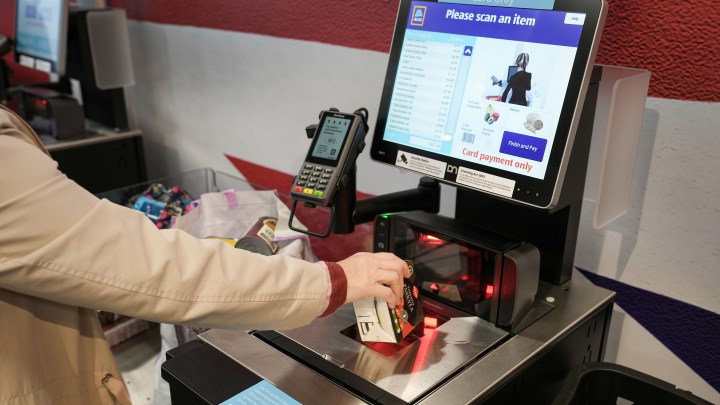
The shortcomings of self-checkout

When you go to a grocery store or pharmacy, do you prefer the self-checkout lines that have become ubiquitous in the modern retail environment? Or do you dread them because you know you’re bound to have trouble scanning your items, paying for them, placing them in the bagging area and getting on your way?
Self-checkouts and their shortcomings are the subject of a new piece in The Atlantic written by Amanda Mull. She spoke with “Marketplace Morning Report” host David Brancaccio about how self-checkout has failed to deliver on its promises for both retailers and consumers.
The following is an edited transcript of their conversation.
David Brancaccio: All right, we’ve had these gizmos, I don’t know, it seems like almost a quarter-century now. What was the selling point originally back then?
Amanda Mull: Well, the selling point has always varied a little bit depending on whether you’re a shopper or you’re a retailer. The selling point that retailers told consumers about was that they are a marvel of efficiency: You will grab and go and be done with your errands in record time. But the way that they were sold to retailers by the vendors that build them, it was a promise of labor savings. So, basically, one person overseeing a corral of 10 self-checkout kiosks is a lot cheaper than 10 people ringing 10 registers on 10 lines.
Brancaccio: I look at these things, and besides seeing them as costing human jobs, I see them as like your worst social studies teacher in middle school: devices that are superjudgmental. “Please place your item in the bagging area.” “I have already placed my item in the bagging” — you know, that kind of situation. They can be extraordinarily unpleasant from the customer point of view.
Mull: They make you feel like you’re under surveillance, first and foremost, even if you’re trying to genuinely pay for everything that you have brought to the register. They make all kinds of noises. They have flashing lights when you put something down in the wrong spot or when it weighs a different amount than the register was expecting it to weigh, through no fault of your own. And it’s a really good reminder that a lot of this stuff was sort of always happening in these transactions, but an employee was doing it.
Brancaccio: A lot has been made of supposedly rising levels of theft in stores across the country, although we find that concrete data to back up that trend is a little hard to come by. But you take some time to explore the relationship between using machines to check out and theft in stores. What did you find?
Mull: Yes, this is a really interesting point because, as you said, there’s no proof that there has been, like, a sudden, recent, catastrophic rise in shoplifting. The data, it just is not there to suggest that that’s true.
But what is true is that in the decades that we’ve adopted the self-checkout machines in more and more applications, these machines come with an ingrained amount of theft that they create, that wouldn’t be there otherwise. And retailers have always been aware of this. And you get that because there’s just nobody watching, a lot of times. There’s one harried employee running around trying to solve the errors in everybody’s transactions, but there’s nobody just sort of like minding the store.
Brancaccio: So, where are we in 2023? You say some retailers are rethinking these, easing some of them out?
Mull: So what you see is retailers adding more employees to the self-checkout area, which takes some of the “self” out of self-checkout. Walmart and Costco, in particular, have decided to staff those areas more consistently and have been promising customers that, if you’re at self-checkout and you want an employee to check out all of your groceries for you, then an employee will do that for you. You don’t have to do it yourself, even if you’re at one of those kiosks.
So, you’ve got bigger retailers, especially, where people buy lots and lots of stuff in a single purchase more commonly, just trying to find a way to sort of reverse-engineer more customer service back into the checkout process because they’re losing more money on this, in a lot of cases, than they’re saving by cutting labor.
There’s a lot happening in the world. Through it all, Marketplace is here for you.
You rely on Marketplace to break down the world’s events and tell you how it affects you in a fact-based, approachable way. We rely on your financial support to keep making that possible.
Your donation today powers the independent journalism that you rely on. For just $5/month, you can help sustain Marketplace so we can keep reporting on the things that matter to you.

















